Responding to trends
in global trade
(page 205)
What trends are evident in
global trade, and how might the following players respond?
- An MNE in Europe
- The government of a
developing country
- An MNE in a developing
country
|
|
Developing and transitional countries are the new
emerging forces in global trade. Countries rich in natural resources are
benefiting from global demand. The countries of the developed world,
traditionally the major traders, are now becoming relatively less
influential as a more diverse picture emerges. In response to the three
examples:
-
An MNE from Europe
– This company
is likely to find that it is exporting more to emerging
markets,
but its home environment
is high-cost.
Because of globalized production, this
company is under
pressures to reduce costs and improve efficiency. It will be
considering production in a low-cost country, in order to export
from here to all markets.
|
Share of 2006 world
merchandise export
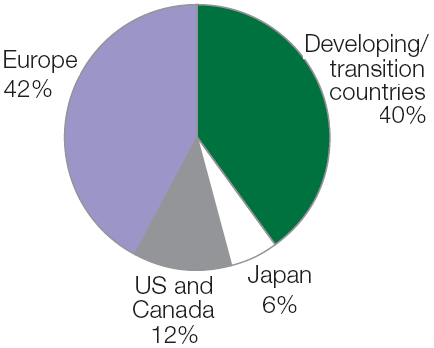 |
The government of a developing
country – This answer depends on the
trade profile of the country. If it is a poor sub-Saharan African
country dependent on agricultural commodities, the government will
try to encourage exports to rich countries, although they face trade
barriers. If it is rich in natural resources such as oil or gold,
exports can bring wealth to aid development, although in many
African countries, resource wealth has not yielded the development
that leaders had hoped for. Given appropriate conditions and
available workers, the government can attract export-oriented FDI,
in the hope that this will bring jobs and prosperity.
An MNE in a developing country
– The MNE may take advantage of the
increasing integration of developing countries in global trade. If
it is a manufacturer and its location is reasonably near good port
facilities, it can export to countries worldwide. It might also
consider FDI in another developing country, or a developed one, from
where it can serve new markets.
|
Trade and globalization
(page 209)
In what ways do the theories of trade
highlighted in this section explain processes of globalization? To
what extent do the divisions between winners and losers support
those who warn of the detrimental impacts of globalization?
|
Early theories of trade emphasized the importance
of location. This is true of the theory of comparative advantage and the
theory of factor endowments. These theories envisaged countries engaging
in trade to export goods in which they are more efficient producers, and
importing those in which they are less efficient. This view of how
countries behave is reflected in analysis of globalization, as firms
seek locations which allow them to produce most efficiently. Vernon’s
product life cycle similarly takes this view of country-specific
factors, with the added consideration of where FDI should be located.
Newer trade theories come to terms directly with globalized production
and economies of scale.
-
Trade theories highlight national gains from
trade and the effects of trade on different groups in society. Those
who warn of the detrimental impacts of globalization will find
evidence to support their views in these theories.
-
Low-cost countries which have built up
manufacturing of mass-market goods have benefited, and workers in
those industries, in particular, have seen wage rises. China is an
example. Losers have been workers in high-cost countries employed in
these same industries.
-
Poor developing countries which have neither
globally competitive industries nor natural resource wealth struggle
to maintain economic growth and prosperity. They are globalization’s
losers. They lack sufficient wealth to import the goods and services
they need, and risk falling behind in human development indicators.
-
Critics of globalization point to the widening
inequality in societies as well as the gap between the wealthier
emerging economies and the least-developed countries.
|
Assessing the theory of competitive
advantage
(page 211)
In what ways is Porter's theory an
advance on earlier international trade theories? What criticisms can
be leveled at the 'diamond' analysis, and to what extent do you feel
they are valid?
|
First, summarize Porter’s theory. Porter’s theory
looks at four specific aspects of a country’s environment, as well as
two other variables, including the role of governments. This is more
comprehensive than earlier theories, and therefore the theory of
competitive advantage presents a richer picture of the country.
Still, critics argue that Porter’s theory is too
limited, citing the following points:
|
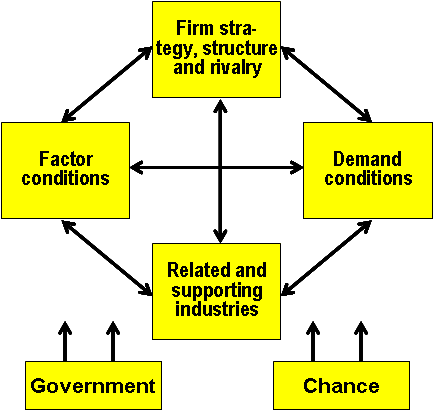 |
-
The diamond of the company’s home country is
not as influential a determinant as Porter portrays. The national
diamonds of other countries where the MNE does business are equally
influential.
-
The role of government is underestimated.
-
Cultural environment is underestimated.
It is probable, but not necessary, that you will
agree with these criticisms, but the theory is still highly influential
and, with modifications, is useful for cross-country comparisons.
|
Do countries or
firms compete?
(page 212)
It is relatively easy to see how
firms compete, that is, by selling products in markets. How do
countries compete? With its booming economy and rising exports,
China is now an economic superpower, and China's firms are highly
competitive globally. Why, then, is China ranked relatively lowly in
competitiveness rankings?
|
How do countries compete?
Countries compete in terms of their business environment. The cultural,
political and legal environments of a country can be perceived as
favorable for business or disadvantageous. Government policies can
influence these aspects of the environment, for example, by fostering an
independent legal system. Often, a country presents a mixture of some
aspects which are advantageous and some which are potentially
detrimental. Choosing a location for FDI involves assessing these
country differences. In a world of footloose MNEs, governments typically
offer incentives to attract FDI. |
|
Why is China ranked comparatively low in the competitiveness
rankings?
-
Note the
criteria used by the organizations which publish rankings. China is
ranked lower in the WEF ranking, shown alongside, than in the IMD
one, although even in the IMD one it is only 15th.
-
Looking
at the criteria, government efficiency and economic prosperity are
two in which China is weaker than the more developed economies. The
still-vast rural population has enjoyed less of the prosperity and
improved well-being of the urban areas (and people here often rely
on remittances from migrant workers in urban areas).
-
See text
on p. 212 for WEF’s reasons for ranking China only 34th:
-
weak
institutions,
-
bureaucracy and
-
low
educational levels.
|
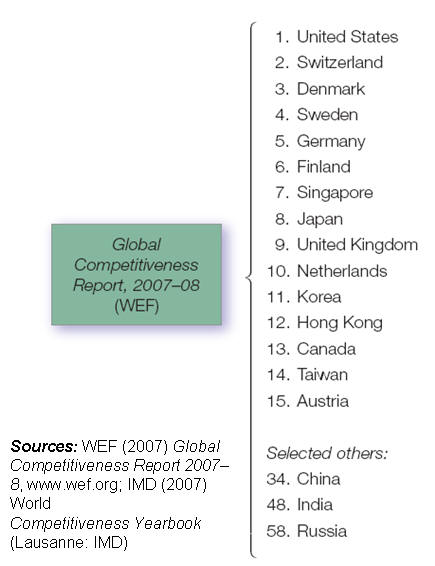 |
Bilateralism rules,
but who gains?
(page 220)
Why do bilateral agreements pose a
threat to the WTO and multilateralism? If the countries entering
these preferential agreements are happy to do so in their national
interest, why should there be any wider cause for concern?
|
Why do bilateral agreements pose a threat to the WTO and
multilateralism?
Countries which perceive that their interests are better served by
reaching bilateral trade agreements with trading partners are not as
motivated to devote effort towards multilateral agreements. As the main
international body promoting multilateralism, the WTO could be weakened
as a result. The piecemeal approach of both bilateral and regional
agreements represents a retreat from aims of the WTO, which were to
liberalize world trade. The WTO is a descendent of the post-war global
financial institutions
―
products of the aspiration towards global governance mechanisms. This
aspiration would be weakened by setbacks to the WTO.
If the countries entering these preferential agreements are happy to do
so in their national interest, why should there be any wider cause for
concern?
Many in the powerful countries such as the US
would probably argue that the proliferation of preferential trading
agreements is beneficial. However, there are causes for wider concern:
-
The spaghetti bowl of cross-cutting trade
agreements adversely affects MNEs, as legal complexities abound in
these agreements, and there may be several different relevant
agreements in cross-border activities.
-
These agreements are almost always lopsided,
favoring the stronger partner. The poorer country is likely to feel
pressurized into agreeing terms which are disadvantageous, in order
to gain some access to the richer country’s market. Some of these
terms may well impose other restrictions unrelated to trade.
|
Beyond Nafta
(page 228)
Why is the Nafta model criticized within
the US and in the other member countries? What are the prospects for
future regional integration of the Americas?
|
Why is the Nafta model criticized within the US and in the other member
countries?
The Nafta model is a free-trade area, with the
removal of barriers to trade and cross-border investment between
members. Of the three members, the US is the regional superpower.
Both Mexico and Canada rely heavily on exports to
the US, but for the US, exports to the Nafta region are a little over
one-half of the exports to the non-Nafta countries.
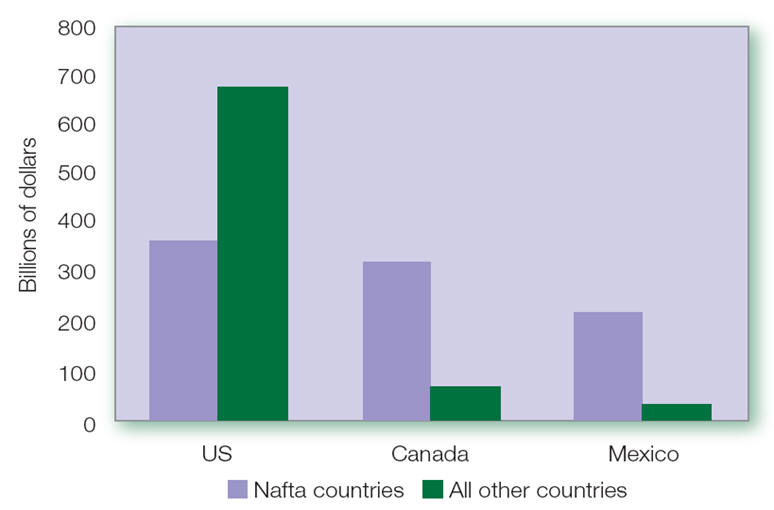
Also, after 15 years of Nafta, Mexico remains a
poor developing country. There is much criticism of Nafta in the
US as well, as US jobs are alleged to have migrated to Mexico.
What are the prospects for future regional
integration of the Americas?
The US has aspired to lead a free trade area of
the Americas, but this has encountered obstacles, in that Venezuela and
Brazil, both significant exporters, have articulated their own interests
and goals, which would cause potential friction with US interests.
The US has looked to the Central American and
Caribbean countries to form a free trade area (Cafta). This is based on
a hub-and-spoke pattern, with the US at the hub. Cafta has been
criticized within the US by businesses fearful of cheap imports, and the
six poor countries which make up the ‘spokes’ are also fearful that they
will be vulnerable to agricultural imports from US agribusiness.
|
European economic integration
(page 230)
In
which respects has regional integration progressed significantly,
bringing benefits to EU citizens? In which respects has integration
been weak and why?
|
In which respects has regional integration progressed significantly,
bringing benefits to EU citizens?
The free movement of people among EU states has
been beneficial, although there have been some restrictions on people in
the newer member states who wish to work in EU 15 countries. Economic
integration is most marked in the euro-zone countries, as the single
currency has facilitated cross-border business. EU member states’ trade
is dominated by other member states (see Figure below).
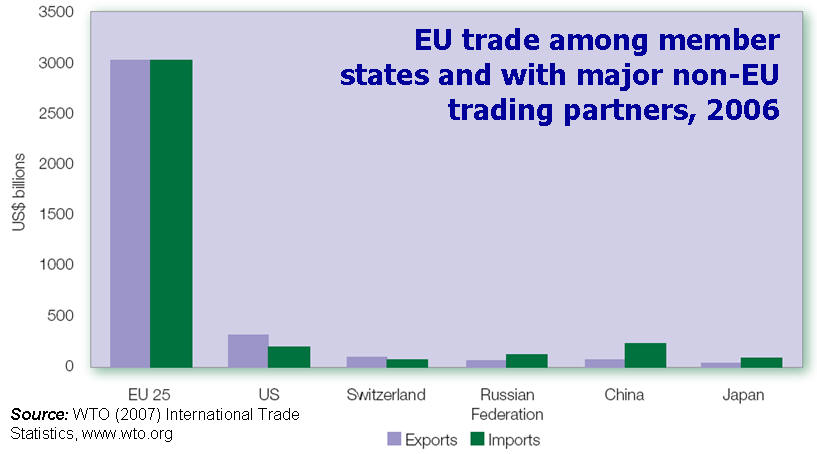
In which respects has integration been weak and why?
Integration has been weaker in services across borders (e.g. financial
services) as regulation remains with national authorities.
|
See Figures 2 and
3. China imports fuel and other natural resources from African countries.
Its exports to Africa are manufactured goods. These include vehicles for
infrastructure projects, which are typically part of the trade deals which
China negotiates with African governments.







